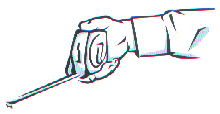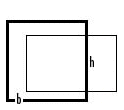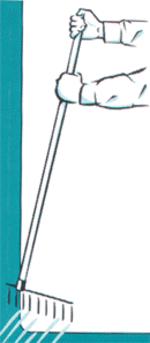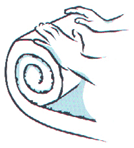Install Guide

To accurately measure your yard, the following measuring aids will be of help
 Circle
Circle
A=3.14 x r2
Example: Circle's radius (r) is 10 feet. Multiply the known 3.14 by the radius squared.
Thus A=3.14 x 102
A=3.14 x 100
A=314 square feet
 Square & Rectangle
Square & Rectangle
A=Base x Height
Example: Square's or Rectangle's base is 10 feet, and the Square's or Rectangle's height is 10 feet.
Thus: A= 10 x 10
A= 100 square feet
With a tape, measure the area of your planned lawn. Include these measurements on a sketch of the lawn area, with the length, width, and any unusual features. Your West Coast Turf Representative will be happy to determine the amount of turfgrass sod you will need from your sketch.
Schedule your order for delivery of turf after preparatory work is completed and you are ready to install. Prompt installation on the day of delivery is crucial to a strong beginning for your lawn.
 Soil Preparation
Soil Preparation
For best result, rototill or spade the area to a depth of 4 to 6 inches. Eliminate drainage problems by having soil slope away from foundations, etc. It's extremely important that your irrigation system is installed and tested before installing your fresh turf.
Rake in fertilizer, lime, peat, compost, sand, etc. as needed to a depth of 3 to 4 inches. In the Desert Southwest, it is prudent to incorporate soil amendments into the top 2 to 4 inches of the soil profile. Gypsum should be applied at 50# to 100# per 1,000 square feet to help in the leaching of salts and buffering of soil pH. Incorporating a starter fertilizer like Soil Burst™ 4-4-2 Pre-Plant or 6-24-24 with minor elements is recommended at a rate of 9-10 lbs per 1,000 square feet.
Rake and smooth the soil, removing rocks, roots, and large clods. Roll the area lightly with a lawn roller 1/3 full of water. This will firm the soil surface and reveal low areas that need more soil. Keep the grade 1 inch below sidewalks or driveway.
Water the prepared area to settle soil and provide a moist base for turf. Moistening to a depth of 6 inches is recommended for moist soils.
Install your lawn immediately upon delivery. Begin watering lawn within 30 minutes of installation. Turf is a living plant that requires ground contact and moisture to survive!
 In hot weather, protect unlaid turf by placing stacks in shade, covering with moist burlap sacking, and/or sprinkling.
In hot weather, protect unlaid turf by placing stacks in shade, covering with moist burlap sacking, and/or sprinkling.
Begin installing turf along the longest straight line, such as a driveway or sidewalk. Butt and push edges and ends against each other tightly, without stretching. Avoid gaps or overlaps. Stagger the joints in each row in a brick-like fashion, using a large sharp knife to trim corners, etc. Avoid leaving small strips at outer edges as they will not retain moisture. On slopes, place the turf pieces across the slope.
To avoid causing indentations or air pockets, avoid repeated walking or kneeling on the turf while it is being installed or just after watering.
After installing the turf, roll the entire area to improve turf/soil contact and remove air pockets.
Most importantly, be sure to begin irrigating right away. Your farm fresh turf will thrive with the proper care.

